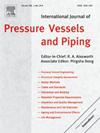基于焊接材料选择提高热等静压薄壁胶囊高温性能的研究
IF 3
2区 工程技术
Q2 ENGINEERING, MECHANICAL
International Journal of Pressure Vessels and Piping
Pub Date : 2025-05-19
DOI:10.1016/j.ijpvp.2025.105562
引用次数: 0
摘要
热等静压(HIP)是一种用于制造高性能零件的粉末冶金工艺,其中胶囊起着驱动粉末致密化的作用。由于胶囊本身的物理性质导致了局部热压传递不充分和不均匀的现象,因此对胶囊进行减薄成为一个重要的解决方案。胶囊壁变薄不可避免地会带来失效的风险,特别是在焊接处,因此胶囊的质量控制至关重要。为了达到提高接头质量的目的,本文研究了采用不锈钢丝焊接低碳钢的HIP工艺中激光电弧复合焊接头。结果表明:焊接接头热影响区极易发生高温塑性损失,高温塑性损失将成为胶囊运行过程中的潜在风险;此外,研究表明,较薄的钢板更容易受到焊接作用的影响。由此产生的焊接应力有可能损害胶囊调节形状的能力,并可能导致高温塑性损失。根据这些发现,本文提出了一种解决方案,即用均匀焊缝代替非均匀焊缝。从焊接原理上看,这种改进有望普遍地减弱焊接应力。此外,在焊缝和母材之间引入等强度匹配方法,预计将导致在热影响区发生高温塑性损失时,焊缝区域参与变形过程。这反过来又有望抑制脆性断裂的发生,从而加强焊接接头。本文章由计算机程序翻译,如有差异,请以英文原文为准。
Study on the enhancement of high-temperature performance of hot isostatic pressing thin-walled capsule based on weld material selection
Hot isostatic pressing (HIP) is a powder metallurgy process used to manufacture high-performance parts, in which the capsule plays the role of driving powder densification. While the physical properties of the capsule itself lead to the phenomenon of insufficient and non-uniform localized heat and pressure transfer, thinning of the capsule becomes an important solution. Inevitably, capsule wall thinning will bring the risk of failure, especially at welded joints, so the quality control of the capsule is crucial. In order to achieve joint quality enhancement, this paper investigates the laser arc composite welding head used in the HIP process, which uses stainless steel wires in the welding of mild steel plates. The results show that the heat-affected zone of welded joints is characterized by the susceptibility to high-temperature plastic loss, which will become a potential risk during capsule operation. Furthermore, it has been demonstrated that thinner plates are more susceptible to the effects of welding action. The resultant welding stresses have the potential to compromise the capsule's capacity to regulate shape, and may precipitate high-temperature plastic loss. In light of these findings, this paper proposes a solution that involves replacing the heterogeneous weld with a homogeneous weld. This modification is expected to universally weaken the welding stress from the welding principle. Furthermore, the introduction of an equal-strength matching method between the weld and the base material is anticipated to result in the involvement of the weld region in the deformation process when high-temperature plastic loss occurs in the heat-affected zone. This, in turn, is expected to inhibit the occurrence of brittle fracture and thereby strengthen the welded joint.
求助全文
通过发布文献求助,成功后即可免费获取论文全文。
去求助
来源期刊
CiteScore
5.30
自引率
13.30%
发文量
208
审稿时长
17 months
期刊介绍:
Pressure vessel engineering technology is of importance in many branches of industry. This journal publishes the latest research results and related information on all its associated aspects, with particular emphasis on the structural integrity assessment, maintenance and life extension of pressurised process engineering plants.
The anticipated coverage of the International Journal of Pressure Vessels and Piping ranges from simple mass-produced pressure vessels to large custom-built vessels and tanks. Pressure vessels technology is a developing field, and contributions on the following topics will therefore be welcome:
• Pressure vessel engineering
• Structural integrity assessment
• Design methods
• Codes and standards
• Fabrication and welding
• Materials properties requirements
• Inspection and quality management
• Maintenance and life extension
• Ageing and environmental effects
• Life management
Of particular importance are papers covering aspects of significant practical application which could lead to major improvements in economy, reliability and useful life. While most accepted papers represent the results of original applied research, critical reviews of topical interest by world-leading experts will also appear from time to time.
International Journal of Pressure Vessels and Piping is indispensable reading for engineering professionals involved in the energy, petrochemicals, process plant, transport, aerospace and related industries; for manufacturers of pressure vessels and ancillary equipment; and for academics pursuing research in these areas.

 求助内容:
求助内容: 应助结果提醒方式:
应助结果提醒方式:


